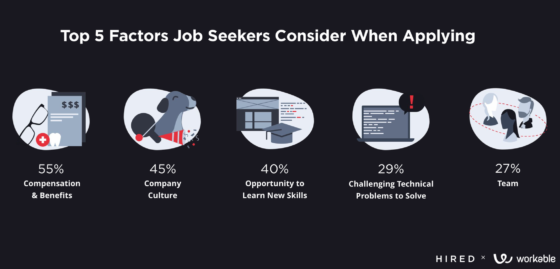6 candidate experience best practices

“Candidate experience is just another HR buzzword.”
“Focusing on candidate experience will hurt my time to hire.”
“No matter what I do, rejected candidates will always post bitter comments online.”
“I can’t measure candidate experience, so how am I supposed to improve it?”
These are some common concerns among recruiters and HR professionals when the hot topic of candidate experience is raised. But are they valid?
Those concerns – and more – were discussed in a webinar on Feb. 21, 2019, co-hosted by Workable and Hired, titled “What Talent Wants: Creating a winning candidate experience”. Matt Buckland, Workable’s VP of Customer Advocacy, and Kelli Dragovich, Hired’s SVP of People, joined forces to talk about candidate experience; why it matters, what motivates candidates, and why some common notions around it are just myths.
In between interesting stats, anecdotes from the speakers, and questions from the audience, we got six key takeaways from this hour-long webinar dedicated to candidate experience best practices. We’ve also recorded the entire session so you can watch at your pleasure:
1. Candidate experience should not be an afterthought
You need to plan it in advance and take into consideration factors that impact the candidate experience, such as different locations where you’re hiring, different roles within your organization and different demographics.
Kelli highlighted that it’s important to take note of things like your goals, your hiring volume and your time to hire when you think of your candidate experience: “Because if you’re only hiring five people in New York next year, that can be a very different experience that you would set up, versus again, hiring 400 people in London, in Dublin, in New York, in San Francisco, etc.”
So, decide on your best candidate experience strategy beforehand and when you’ve locked that down, you can proactively inform candidates and set them up for success. That gives you extra points, according to Matt: “Because the biggest thing that was going to generate fear is that uncertainty. It’s the unknown for a candidate. It’s like, ’Okay, I’m going into this process. What’s it going to be like?’”
It’s also important that the entire hiring team is lined up, Kelli added. Do all interviewers know what they’re supposed to ask before they meet with candidates? Or do candidates leave more confused than they did coming in? ”Because that’s the quickest way to turn off a candidate, that I’ve seen,” Kelli said.
The hiring team should sync long before the actual interviews, so that they all know what to ask and ensure their messaging and expectations are consistent.
2. Candidate experience is not only what you deliberately do
There are things you can control and things you can’t. As Matt said, candidate experience begins before your first interaction with candidates.
“Before you’re on the phone with them, before they even hit that apply button, they’re already having an experience. And it’s probably not the one you want them to [have]. If you’ve got a dodgy website, or a really cheesy careers page with the CEO digging a tree because you’re so committed to the environment and it looks really hackneyed, they are having that experience.”
So, when thinking of your candidate experience strategy, you have to look at the bigger picture. You have to consider your brand, what job seekers learn about you when they’re visiting your website, searching your company on social media and asking the opinion of their friends who work or used to work at your company. Here are the top five factors that motivate candidates to apply, as presented during the webinar:

3. The job offer is not the end of the candidate experience
Yes, for the recruiter it might be the end when the candidate accepts the job offer, but for the candidate it doesn’t stop there. And that gap could actually cost you candidates. Matt explained: “I have seen some brilliant examples of this, and how people have gone on to really win people over. And similarly, how people have been offered other jobs at other companies and then sneaked away during that period to other companies because they’ve been treated better.”
Showing people that you care even after they’ve accepted your job offer is a sign of empathy. You didn’t play nice to them just to hook them; you show that you truly want them to come onboard. Matt shared some of the candidate experience best practices he’s seen during his recruiting years, that have helped companies step up their game: “If you find out that the candidate is about to be a parent, you send a branded onesie to them, and suddenly you’re the best person in the world because you’ve taken notice of something massive that was happening in their life and you’ve actually played it back saying, ‘We care. Look, we do care.’ If you do that genuinely, if you do that authentically, I think that’s a brilliant thing to do.”
4. Candidate experience is measurable
Something as qualitative as “experience” is not easy to measure. Matt suggested, though, how to gather feedback from candidates: “Anyone who got to a meaningful stage in our interview process, we sent them an NPS. ‘Would you recommend us as a place to work?’ And then because they were already answering the question, we [sneak in three] other ones about speed of the process, the communications from the recruitment team, and the comments from the interviewers.”
By keeping this candidate experience survey short and targeted, you can get immediate insights about things that you can change. Beyond asking candidates directly, Matt also recommended checking on your reports. For example, if many of your candidates are dropping out of the assessment, that’s a hint that you need to improve that stage. You could try, for example, to get rid of that assessment or replace it with another one and measure the impact that it has on your candidate flow.
5. You can make a good impression even in difficult scenarios
Offering a great candidate experience might be easy when you’re a popular brand or when you have amazing offices to showcase. But sometimes it’s not that easy. The two speakers talked about cases where a positive candidate experience doesn’t come off so naturally:
When it’s time to reject candidates
It’s never fun to turn candidates down. But it’s not something you should neglect. While you’re busy welcoming your new hire, one or more rejected candidates who never heard back from you could be filling out a negative review on Glassdoor or sharing their poor experience all over social media.
Sending a rejection email is the bare minimum you can do. Matt shared some candidate experience best practices and tips from his own recruiting experience on how to leave a good impression: “For me, I think the further they are in that process, the more you should do to give them actual feedback. If they’ve invested time, you should invest that and reflect that back to them. So we had a rough rule of thumb, which was if you just did a phone screen, I’m probably just going to send you an email to reject you. If you came in, I’m definitely going to give you a call. If you’ve got to second, third stage, I’m definitely going to give you a longer call. I’m going to give you concrete feedback. I’m going to give you tips that you can use for next time.”
When your company has a negative reputation
How do you turn this around? Kelli talked about the importance of not rushing things; first, you need to understand why you have this reputation and then, try to change it. She recommended discussing with former employees and internal team members, as they’ll help you identify weak points that you can immediately start working on.
For Matt, a negative brand is not always a bad thing; it can be an opportunity to discuss deeper with candidates and explain to them what working at your company really looks like. And here’s the trap: you don’t have to appear as the “perfect employer” during interviews. Candidates can spot fakeness. But if you’re being transparent about something that could be improved at your company, you set the stage for an honest relationship with candidates.
“You’re giving them a con, which means they won’t be looking for one. It also adds credit to your authenticity later on. ‘Well, they admitted that to me. Maybe that is the highest they can go on the salary.’ So you’re adding credence to yourself,” Matt explained.
When you’re hiring remote employees
Impressing candidates over video is not an easy task. But you can still be friendly and well-prepared. “The location is remote. The people involved shouldn’t be remote,” Matt said.
You can adjust the time of the interview to accommodate different time zones, you can run practice tests with interviewers so that they’re all relaxed during the actual interview, and you can help candidates feel more comfortable, too. “Everything you can do to keep that process and that environment as natural as possible, the better,” Kelli added.
6. It’s a buyer’s market
Companies should not take candidates’ interest for granted. They have choices and they have standards. And your job is to sell your company as best as possible. “I think if you’re good at what you do, you’re always going to find people. People will be attracted to you. But in this exact case, you are noticeably wrong if you think they’ve got no other job offers,” Matt said.
That’s why, he continued, it’s important to take some things off the table from the beginning. For example, in the job ads you can include the salary (range) and links to the team’s LinkedIn profiles. Candidates will immediately get an idea of the role and the company before you even talk to them.
Kelli talked about how you can use interviews not just to learn more about candidates, but also to describe your own company and to connect with the candidates. “But I’ve seen more and more now that it’s almost an expectation for them to also be inspired, by the team, the company and the mission. They’re choosing where to go.”
They’re also choosing where not to go – and they will talk about it whether you know it or not. Don’t underestimate how many people a candidate will tell about their experience. “They will tell everyone, and it’s not just the people who are angry enough to write it down,” Matt clarified. And Kelli added “Having a new job is a big life event. And so I’m sure that candidates tell 10 friends, not just after but, ‘Hey, I’m going to go interview at Workable today.’ ’Great. Tell me how it goes.’ And they follow up.”
And those friends of the candidates are potentially your next candidates, if you’ve left a good impression. “I’ve had people say, ‘Hey, I didn’t get the job, but I loved it. And I told three friends how great it was.’”
“So no matter what, and no matter if that candidate wants to be at your company or not, or you want them or not, make them feel fantastic.”
In short – when you put out the word about a new opportunity at your company, you’re also putting out the word about your company itself and what it might be like to work there – whether deliberate or not. Everyone has a horror story about a bad candidate experience and those stories spread like wildfire. You don’t want to be the “baddie” in that horror story – the repercussions for that are widespread – so, take Matt’s and Kelli’s advice and make sure you have the best candidate experience strategy possible.
Check out our tutorial on how to improve candidate experience in your company.




